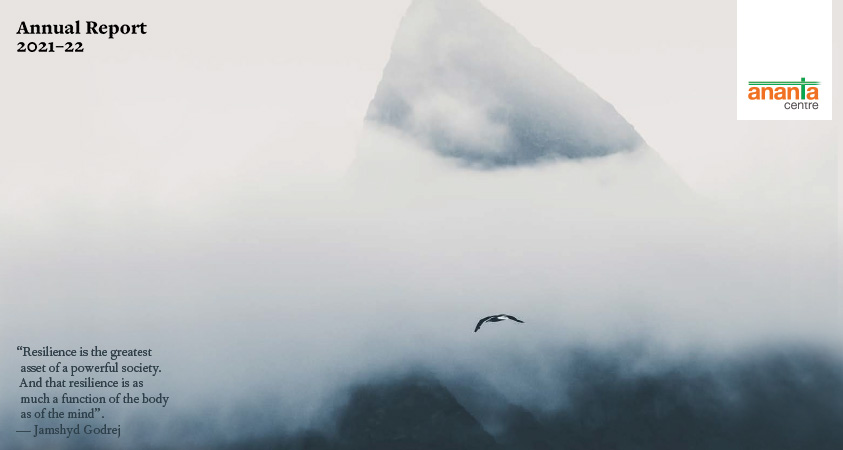H I G H L I G H T S
• Winter Parliament session gives key economic bills a miss
• Farm laws repealed and electoral laws amended
• No change in RBI policy stance & benchmark interest rates
• Effective hike in reverse repo rate through an indirect route
• Growth projection retained at 9.5%, Omicron notwithstanding
• Inflation projected to stay below the upper tolerance band
• New policy to strengthen prudential norms for NBFCs
• NBFC framework may be the thin end of the wedge
• How the PCA framework will operate
• Wholesale inflation reaches record high in November
• No relief from retail inflation either despite fuel duty cut
• PLI scheme for semiconductors
• Port reforms take away tariff powers of regulator
Winter Parliament session gives key economic bills a miss
Expectations of the winter session of Parliament that ended in the last week of December were high. Several economic bills were likely to be introduced, giving the much-expected big push to reforms in the Indian economy. A few of these key legislative initiatives were to facilitate the privatisation of two state-owned banks, delicense the electricity distribution sector and provide a statutorily backed regulatory framework for cryptocurrencies. In the end none of these bills got introduced during the short session that lasted less than four weeks. Bank privatisation was promised in the Budget announced in February 2021. The electricity law was proposed to be changed to introduce competition among private distributors. A new law on cryptocurrencies was to have ended the perceived difference of views on the legal status of cryptocurrencies between the central bank and the government. Hopefully, the Budget session, expected to start in the last week of January 2022 would shed more light on all the three key economic reform issues.
Farm laws repealed and electoral laws amended
What the winter session of Parliament, however, did achieve in terms of its legislative agenda was no less significant. Productivity in the Lok Sabha was 77 per cent and much lower at 43 per cent in the Rajya Sabha. But 12 new legislative bills were introduced during the session and 11 bills were passed. The most important bill passed by Parliament in the winter session repealed the three agricultural laws that had led to a year-long farmers’ agitation in parts of the country. Three other important laws were amended. In two of those amendments, the tenure of the Enforcement Director and the head of the Central Bureau of Investigation could be extended beyond two years in instalments of one year each till the completion of five years from the initial appointment. The third amendment allowed the enrolment of voters on the completion of four qualifying dates in a year, instead of only one such qualifying date a year at present. In addition, it allowed the controversial linkage of Aadhaar with the voter’s identity card.
No change in RBI policy stance & benchmark interest rates
The much-awaited bi-monthly monetary policy review for December 2021 did not spring any surprises, dispelling fears that the outbreak of Omicron, a new variant of the coronavirus, could upset the earlier calculations and estimates of the Reserve Bank of India’s Monetary Policy Committee regarding the stance on its policy on interest rates and liquidity management. On December 8, the repo rate (at which banks can borrow from the the Reserve Bank of India or RBI) was maintained at 4 per cent, while the reverse repo rate (at which banks can park their money with the RBI) was kept at 3.35 percent and the monetary policy stance continued to remain accommodative.
Effective hike in reverse repo rate through an indirect route
Those focused only on the unchanged rates and stance would be missing the larger message implicit in the December 2021 monetary policy statement of the central bank. By leaning more on the variable reverse repo rate (VRRR) window to drain out excess liquidity from the banking system, the RBI has sought recourse to what is being described as a reverse repo rate hike by stealth. The central bank has activated most of the money absorption through the 14-day VRRR window, which has been complemented by the 28-day reverse repo instrument. In effect, the traditional fixed rate reverse repo tool has been rendered almost redundant.
Consider the following. By December 3, the RBI had used the VRRR instrument to suck out as much as Rs 6 lakh crore from the banking system. As envisaged under the December 8 policy review statement, the VRRR window was used to absorb a higher amount of Rs 6.5 lakh crore on December 17 and another Rs 7.5 lakh crore on December 31. From January 2022 onwards, liquidity absorption would be undertaken mainly through the auction route, which may consequently raise the short-term rates in the banking system from January 2022. In addition to leaning on the VRRR window, the RBI also changed the marginal standing facility (MSF) to permit borrowing up to 2 per cent of the banks’ deposit base from 3 per cent allowed during the earlier pandemic days. This also tightened the MSF window which banks use for their liquidity support during emergencies.
The RBI move on the VRRR tool has already resulted in a hardening of the interest rate regime. The VRRR facility is now available at about 4 per cent through liquidity auctions, which is the same as the repo rate. If the banks have excess cash, they can park it with the RBI at these VRRR auctions at 4 per cent, compared to the fixed-rate auction under the reverse repo rate window where the rate remains unchanged at 3.35 per cent. In effect, the operating reverse repo rate has gone up, a move that a section of the Monetary Policy Committee has been suggesting for some time.
Growth projection retained at 9.5%, Omicron notwithstanding
On the state of the economy, the RBI maintained its earlier forecast of India’s economic growth for 2021-22 at 9.5 per cent, compared to a contraction of 7.3 per cent in 2020-21. On the positive side, the Monetary Policy Committee opined that the growth momentum was gaining further traction, helped by the increasing coverage of vaccination. The farm sector held out the promise of continued buoyancy. There was an uptick in urban demand and contact-intensive services sector, consumer demand was bouncing back and exports were booming. The RBI did note that the Omicron variant posed a challenge – a warning that appeared to be coming true in the following weeks with the danger of the new variant threatening to spread rapidly in the country and slowing the pace of economic activity.
Inflation projected to stay below the upper tolerance band
Inflation, based on the movement in the Consumer Price Index, was expected to be 5.3 per cent in 2021-22. RBI Governor Shaktikanta Das believed that it was important at this stage to keep inflation “aligned with the target while focusing on a robust growth recovery”. The inflation target is 4 per cent, with a tolerance band of a 2 per cent variation either way. While Deputy Governor Michael Patra remained non-committal on the inflation trajectory, arguing that the jury was still out on whether inflation was durable or transitory, it was clear that the Monetary Policy Committee would be comfortable if the inflation rate stayed within the upper tolerance band of 6 per cent. The expectation is that core inflation (excluding oil and food prices) should begin to decline in the coming weeks, giving the central bank some leeway in managing the price situation over the next one year.
New policy to strengthen prudential norms for NBFCs
In a move to tighten its regulatory supervision of non-banking financial companies (NBFC), the Reserve Bank of India or RBI has put in place a prompt corrective action (PCA) framework for them. In November, the RBI had introduced guidelines to harmonise recognition norms for non-performing assets (NPA) of NBFCs. And now the NBFC sector is to be brought under the PCA framework. The PCA framework, already enforced for commercial banks, ensures that financial intermediaries adhere to prudential norms so that their financial health is not at risk. The NPA framework will be applicable to all deposit-taking NBFCS afrom October 1, 2022, on the basis of their financial position as on or after March 31, 2022. The RBI’s new NPA framework will not apply to those NBFCs, which do not accept deposits and have an asset size of less than Rs 1,000 crore and which are primary dealers, housing finance companies or are owned by the government.
NBFC framework may be the thin end of the wedge
There are over 10,000 NBFCs in the country and only a few of them take deposits. However, the entire NBFC sector is on alert as the RBI may gradually extend the scope of the PCA framework to cover more entities over a period. According to an RBI statement, the regulatory action was because of the growing size of the NBFC sector and “substantial interconnectedness with other segments of the financial system”. Moreover, the statement added: “The objective of the PCA framework is to enable supervisory intervention at an appropriate time and require the supervised entity to initiate and implement remedial measures in a timely manner, so as to restore its financial health”.
How the PCA framework will operate
The central bank has introduced three yardsticks which would be used to measure the three risk thresholds imposed under the PCA framework. The restrictions on the activities of an NBFC would be progressively tightened as it breaches higher threshold levels. A breach of any one of the criteria (the capital adequacy ratio, Tier-I capital ratio and net non-performing assets ratio) will trigger action to bring the NBFC concerned under the PCA framework. If an NBFC under the PCA framework breaches the first threshold, it would face restrictions on dividend distribution. Moreover, promoters will be asked to infuse capital and reduce leverage. Once the second threshold is breached, the NBFC in question will be barred from opening branches. The crossing of the third threshold would invite stricter restrictions like the stoppage of capital expenditure by the NBFCs except that for a technological upgrade. The PCA framework norms are obviously stringent and have understandably caused concerns in the NBFC sector.
Wholesale inflation reaches record high in November
Inflation continued to be a cause for concern for policy makers in December. The November imprint for wholesale inflation was an alarming high at 14.23 per cent, driven largely by elevated food and fuel prices. In October, the Wholesale Price Index (WPI) had recorded a rise of 12.54 per cent. The current series of the WPI was introduced in 2011-12. The December number of wholesale inflation was the highest recorded so far and it remained in double digits for the eighth consecutive month. Worryingly, core inflation (excluding food and fuel prices) climbed to a new high of 12.3 per cent, which according to analysts showed a rise much higher than what had been widely expected. The government explained the rise in wholesale inflation as arising out of a low base effect of last year, but experts are now of the view that the wholesale inflation for the full financial year of 2021-22 could well be in the range of 11.5 and 12 per cent, a record high level since the launch of the current WPI series.
No relief from retail inflation either despite fuel duty cut
December did not see any respite from retail inflation as well. The November 2021 number on retail inflation, based on the movement in the Consumer Price Index (CPI), was 4.91 per cent, higher than 4.48 per cent in October. The increase in retail inflation was despite the decision of the Centre and several state governments to reduce duties on petrol and diesel, which resulted in a fall in their retail prices. The elevated level of retail inflation was due to a rise in food prices to 1.87 per cent, compared to 0.85 per cent a year ago. The November retail inflation level was still below the upper tolerance band of 6 per cent, prescribed under the inflation targeting regime. But there are concerns over whether the trajectory would remain benign in the coming months. Analysts believe that if the economy opens up, there will be increased demand pressure, particularly in the services sector, as a result of which retail inflation in a large number of service industries could see a spurt. Core retail inflation also had risen to 6.9 per cent in November, up from 5.8 per cent in October. The fear is whether the high levels of elevated wholesale inflation are threatening to translate into higher retail inflation in the coming months.
PLI scheme for semiconductors
The government has now decided to use the production linked incentive (PLI) scheme to give a big boost to its dreams of creating a semiconductor industry in the country. The PLI scheme for semiconductor and display board production envisaged an investment of Rs 76,000 crore by the government over a period of five to six years. The incentive scheme will support companies engaged in the production of silicon semiconductor fabs, display fabs, compound semiconductors, silicon photonics, sensor fabs, semiconductor packaging and semiconductor design. The fiscal support for setting up semiconductor fabs and display fabs would be up to 50 per cent of the project cost on a pari passu basis to eligible applicants with the required technology and capacity to execute such projects. Companies including Israel’s Tower Semiconductor, Apple’s contract manufacturer, Foxconn, a Singapore-based consortium and the Vedanta group have shown interest in setting up such fab facilities in the country after taking advantage of the new PLI scheme. For companies keen on setting up compound semiconductors, silicon photonics, sensor fabs and semiconductor units, the fiscal support would be to the tune of 30 per cent of capital expenditure. About 15 companies have shown interest in setting up such facilities. In addition, the government has also decided to modernize and revive the Semiconductor Complex, a state-owned enterprise located in Mohali, near Chandigarh. The semiconductor sector requires abundant supply of pure water, uninterrupted power availability for 24 hours a day and land. The government has therefore decided to work closely with the state governments to ensure that the schemes for semiconductor development face no infrastructure bottlenecks. Building a robust semiconductor industry is of strategic significance in a world where chips shortage can retard economic growth. Semiconductor fab facilities in India would also plug a crucial gap between the abundant domestic availability of design houses and the non-existent fab infrastructure facilities.
Port reforms take away tariff powers of regulator
In what is seen as a major reform in the port sector, the government has decided to abolish the tariff setting powers of the Tariff Authority for Major Ports (TAMP). This will usher in a significant change as major port concessionaires can now set their own market-based tariffs, without the regulatory oversight of TAMP. The new system has been introduced under the revised provisions of Tariff Guidelines, 2021 issued after the notification of the amended Major Port Authority Act, 2021. The new guidelines have allowed the concessionaires at major ports to set tariffs according to market dynamics. The public-private partnerships (PPP) operating as concessionaires in major ports account for almost half of the total traffic handled by them. It is expected that the new provisions would create a level playing field for the PPP concessionaires as they compete with private ports, which are not governed by the tariffs set by TAMP. The new provisions will also be applicable to future PPP projects, including the ones which are currently under the bidding stage. While the new provisions should bring down port costs, they also highlight an area of concern. The government, instead of strengthening the current regulatory framework of TAMP, has decided to make it almost redundant. With more than one-third of the country’s port traffic handling capacity being controlled by one corporate group, it remains to be seen if the principle of market dynamics and level playing field can address the concerns arising out of dominance or near-monopoly powers enjoyed by the port service operators.
Supported by
…………………………………………………………………………………………….
(The views expressed are personal)
………………………………………………………………………………………………























